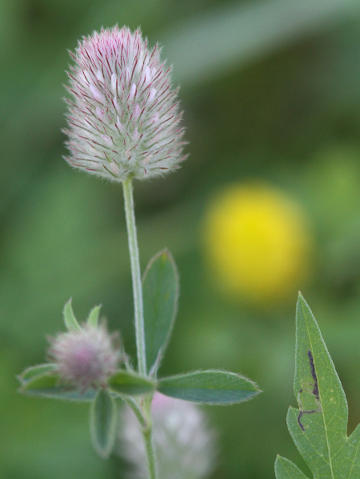

PHOTO COURTESY OF GARRY KESSLER
Kids love to find rabbit’s foot clover, which grows in poor soils and dry, sandy places, such as the former sand pit at the Andrews Street entrance to the Headwaters Conservation Area.
August 24, 2012, Page B4-B5
NATURE NOTES
By Annie Reid
Westborough Community Land Trust
Rabbit’s foot clover is fun for kids
Certain wildflowers are fun for kids, engaging their senses and imaginations. One that’s easy to find right now is rabbit’s foot clover. Even the name sets the imagination to working.
The special part for kids is the fuzzy flowerhead. It is pale pink-gray, with long silky hairs, and wonderfully soft to the touch. Coupled with the name, it easily brings to mind a rabbit’s foot, even for a child who has only met rabbits in storybooks, videos, TV shows, or online. It might even remind some grownups of the “lucky rabbit’s foot” key chains that were once popular trinkets in their childhood.
Like other clovers, the rabbit’s foot clover plant (Trifolium arvense) is low-growing, only 4-18 inches high. Its leaves have the characteristic three leaflets of a clover. As you can see in our photo, the leaflets are long and narrow (rather than the rounder leaflets found on the white clover and red clover that many of us are familiar with).
The flowerheads are easy to spot, either on a single plant at your feet or in masses along the side of a road or a trail. We notice the long hairs on the flowerheads, but much shorter soft hairs cover the whole plant. Bees pollinate rabbit’s foot clover, attracted by nectar in the many small tube-like flowers hidden among the silky hairs in the flowerhead.
Rabbit’s foot clover tends to grow in poor soil and dry, sandy places, so it’s easy to think of it as a weed rather than a wildflower. You’ll see it in vacant lots and sidewalk cracks, as well as along roadsides and in fields.
As an example, one place in Westborough where you can find rabbit’s foot clover during much of the summer is the Andrews Street entrance to the Headwaters Conservation Area. The path between the parking area and the woods passes through what was once a sand pit – not a friendly environment for many plants. Rabbit’s foot clover is right at home there, along with other vegetation that has been gradually reclaiming the area in recent decades.
If rabbit’s foot clover is a weed, then it’s a weed with benefits. For one thing, it’s quite tolerant of drought, as it would have to be to prosper in a former sand pit.
But that’s not all. Like other clovers, it helps to enrich poor soil. Its roots form bumps, or nodules, that house certain bacteria (Rhizobium) that take nitrogen – which is basically a fertilizer ingredient – out of the air and make it part of substances that the plant can use. Rabbit’s foot clover is an annual, so when the plants die and decompose each year, nitrogen-containing substances enter the soil and enrich it. Its ability to capture nitrogen via the bacteria in its root nodules, combined with its drought tolerance, helps rabbit’s foot clover to grow where many other plants can’t.
Like most other clovers, rabbit’s foot clover is non-native. It came from Europe with the early European settlers – mixed in with their farming supplies – and is now widespread and common in North America. It’s largely viewed as an introduced species that has become naturalized, but it is considered an invasive species in some places, such as Hawaii.
Other names for rabbit’s foot clover reveal the imagination at work. Some reflect the plant’s environment, such as oldfield clover and stone clover. Others are inspired by the plant’s appearance, such as hairy clover, pussy clover, pussies, dogs and cats, and hare’s foot.
Try to point out rabbit’s foot clover to a youngster this summer. It has been said that a child who learns the name of at least one wild plant will grow up to care about conserving the natural environment. Surely this approach is worth a try!
Whether you think of rabbit’s foot clover as a wildflower or a weed, it’s a flower that’s beneficial and fun.